Abstract
Recent mass mortalities among several marine mammal populations have led to speculation about increased susceptibility to viral infections as a result of contaminant-induced immunosuppression. In a 2.5-year study, we fed herring from either the relatively uncontaminated Atlantic Ocean or the contaminated Baltic Sea to two groups of captive harbor seals and monitored immune function in the seals. Seals fed the contaminated fish were less able to mount a specific immunological response to ovalbumin, as measured by in vivo delayed-type hypersensitivity (DTH) reactions and antibody responses. The skin reaction to this protein antigen was characterized by the appearance of mononuclear cells which peaked at 24 hr after intradermal administration, characteristic of DTH reactions in other animals studied. These DTH responses correlated well with in vitro tests of T-lymphocyte function, implicating this cell type in the reaction. Aryl-hydrocarbon (Ah) receptor-dependent toxic equivalent (TEQ) profiles in blubber biopsies taken from the seals implicated polychlorinated biphenyls rather than dioxins or furans in the observed immunosuppression. Marine mammal populations currently inhabiting polluted coastal environments in Europe and North America may therefore have an increased susceptibility to infections, and pollution may have played a role in recent virus-induced mass mortalities.
Full text
PDF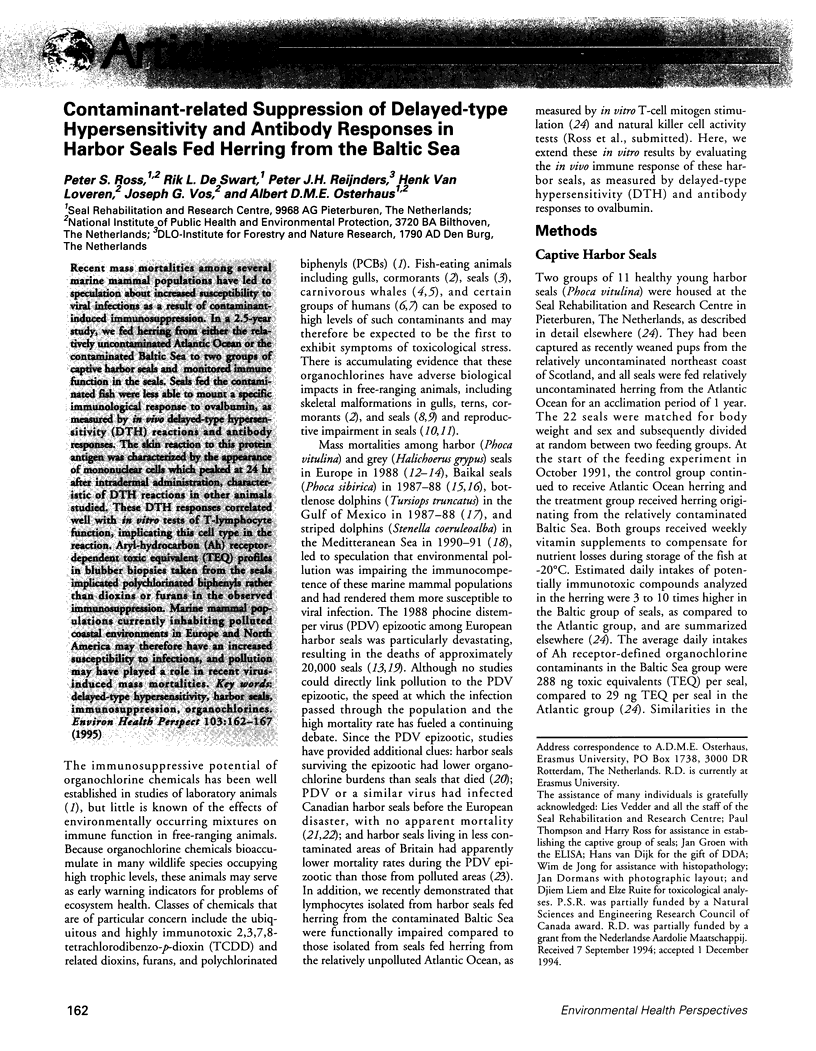

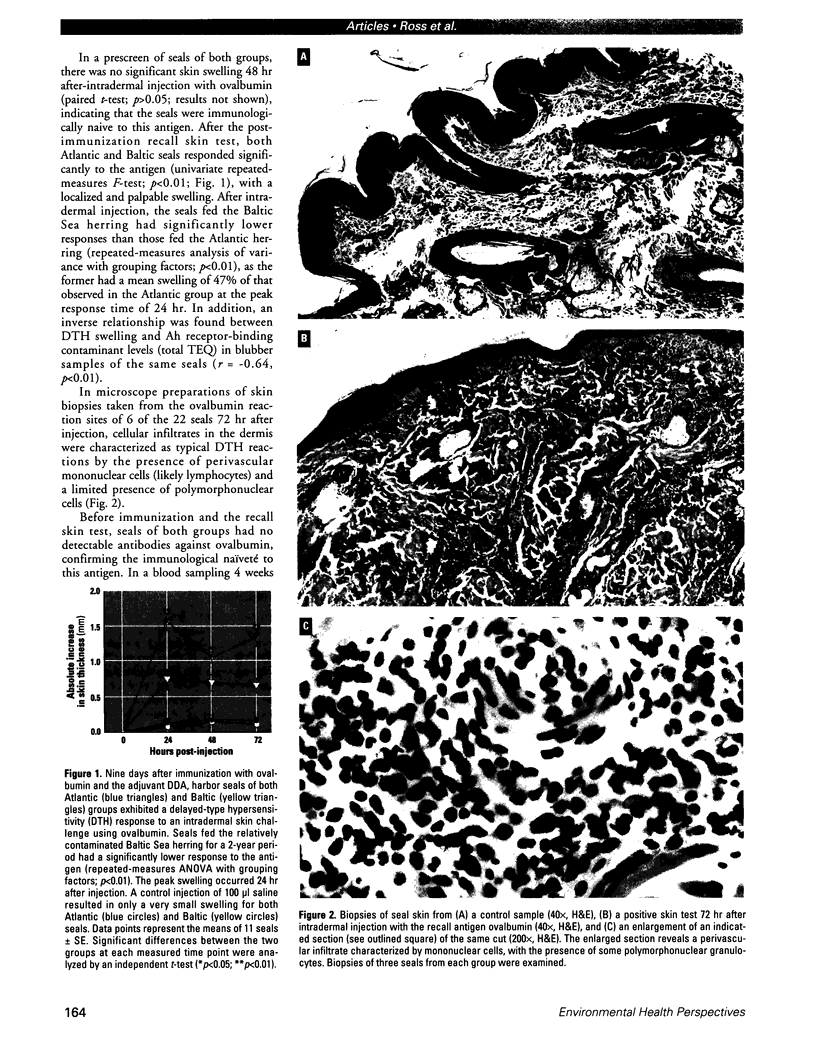
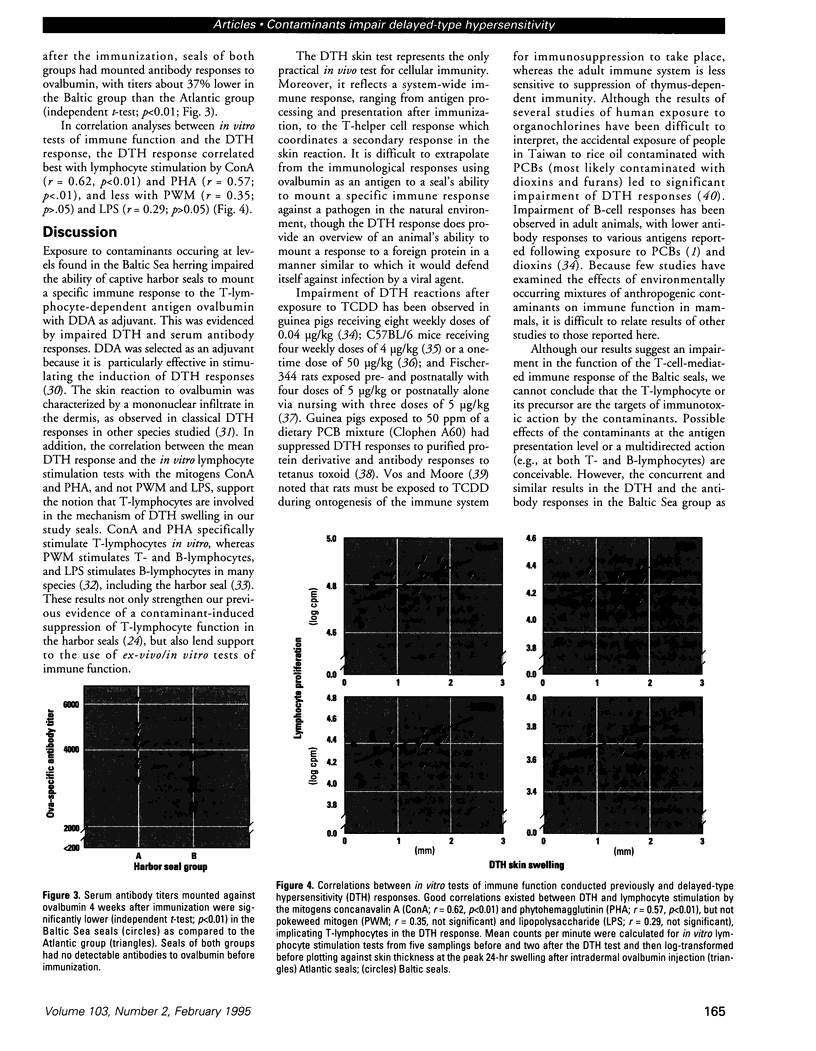
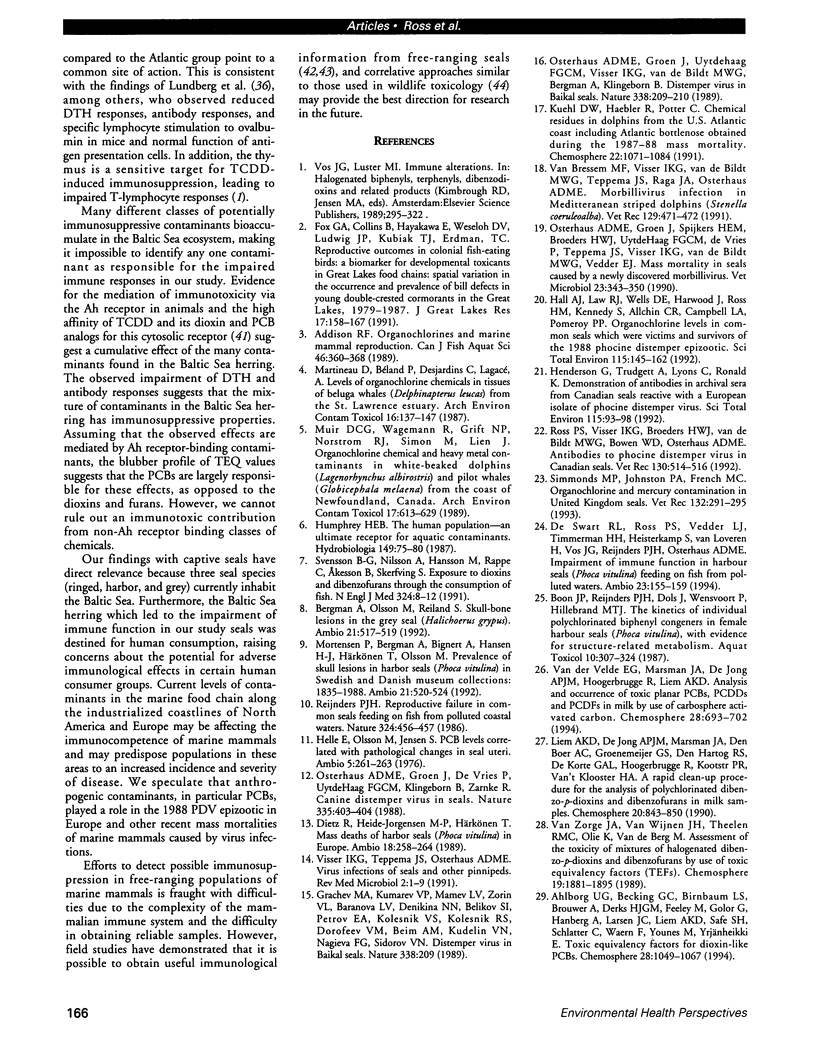
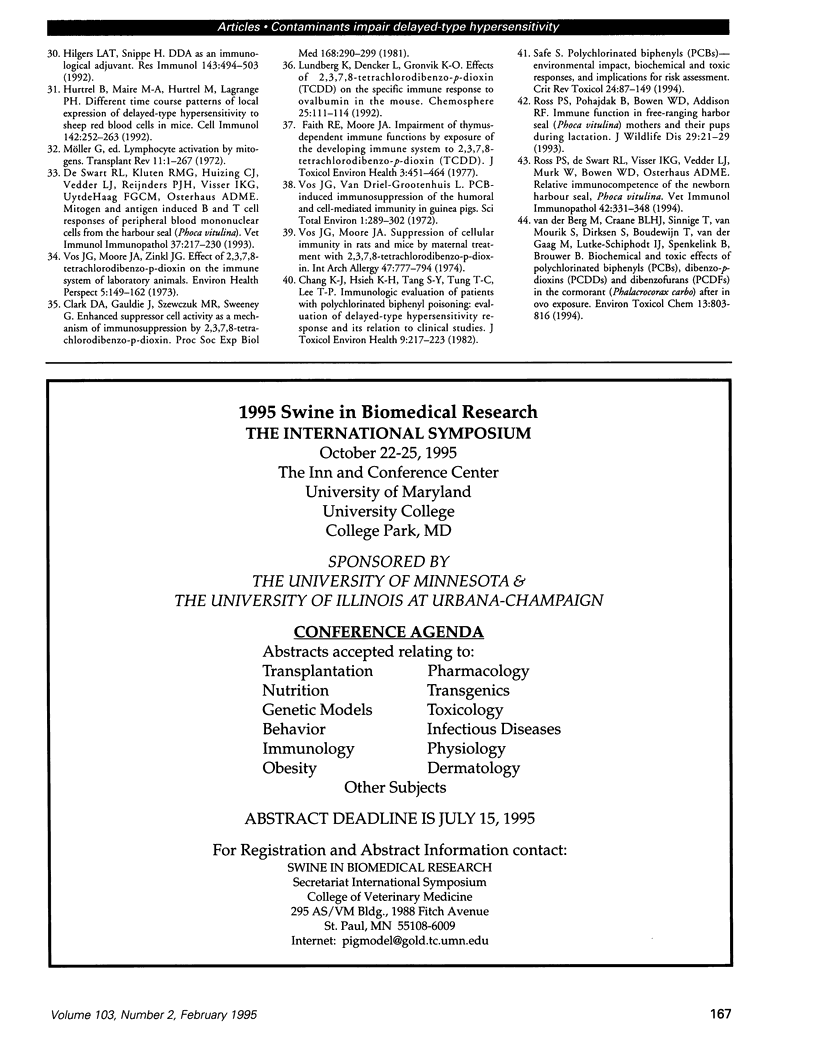
Images in this article
Selected References
These references are in PubMed. This may not be the complete list of references from this article.
- Chang K. J., Hsieh K. H., Tang S. Y., Tung T. C., Lee T. P. Immunologic evaluation of patients with polychlorinated biphenyl poisoning: evaluation of delayed-type skin hypersensitive response and its relation to clinical studies. J Toxicol Environ Health. 1982 Feb;9(2):217–223. doi: 10.1080/15287398209530156. [DOI] [PubMed] [Google Scholar]
- Clark D. A., Gauldie J., Szewczuk M. R., Sweeney G. Enhanced suppressor cell activity as a mechanism of immunosuppression by 2,3,7,8-tetrachlorodibenzo-p-dioxin. Proc Soc Exp Biol Med. 1981 Nov;168(2):290–299. doi: 10.3181/00379727-168-41275. [DOI] [PubMed] [Google Scholar]
- Distemper virus in Baikal seals. Nature. 1989 Mar 16;338(6212):209–210. doi: 10.1038/338209a0. [DOI] [PubMed] [Google Scholar]
- Distemper virus in Baikal seals. Nature. 1989 Mar 16;338(6212):209–210. doi: 10.1038/338209a0. [DOI] [PubMed] [Google Scholar]
- Faith R. E., Moore J. A. Impairment of thymus-dependent immune functions by exposure of the developing immune system to 2,3,7,8-tetrachlorodibenzo-p-dioxin (TCDD). J Toxicol Environ Health. 1977 Oct;3(3):451–464. doi: 10.1080/15287397709529578. [DOI] [PubMed] [Google Scholar]
- Hall A. J., Law R. J., Wells D. E., Harwood J., Ross H. M., Kennedy S., Allchin C. R., Campbell L. A., Pomeroy P. P. Organochlorine levels in common seals (Phoca vitulina) which were victims and survivors of the 1988 phocine distemper epizootic. Sci Total Environ. 1992 Apr 20;115(1-2):145–162. doi: 10.1016/0048-9697(92)90039-u. [DOI] [PubMed] [Google Scholar]
- Henderson G., Trudgett A., Lyons C., Ronald K. Demonstration of antibodies in archival sera from Canadian seals reactive with a European isolate of phocine distemper virus. Sci Total Environ. 1992 Apr 20;115(1-2):93–98. doi: 10.1016/0048-9697(92)90035-q. [DOI] [PubMed] [Google Scholar]
- Hilgers L. A., Snippe H. DDA as an immunological adjuvant. Res Immunol. 1992 Jun;143(5):494–576. doi: 10.1016/0923-2494(92)80060-x. [DOI] [PubMed] [Google Scholar]
- Hurtrel B., Maire M. A., Hurtrel M., Lagrange P. H. Different time course patterns of local expression of delayed-type hypersensitivity to sheep red blood cells in mice. Cell Immunol. 1992 Jul;142(2):252–263. doi: 10.1016/0008-8749(92)90287-y. [DOI] [PubMed] [Google Scholar]
- Muir D. C., Wagemann R., Grift N. P., Norstrom R. J., Simon M., Lien J. Organochlorine chemical and heavy metal contaminants in white-beaked dolphins (Lagenorhynchus albirostris) and pilot whales (Globicephala melaena) from the coast of Newfoundland, Canada. Arch Environ Contam Toxicol. 1988 Sep;17(5):613–629. doi: 10.1007/BF01055830. [DOI] [PubMed] [Google Scholar]
- Osterhaus A. D., Groen J., De Vries P., UytdeHaag F. G., Klingeborn B., Zarnke R. Canine distemper virus in seals. Nature. 1988 Sep 29;335(6189):403–404. doi: 10.1038/335403a0. [DOI] [PubMed] [Google Scholar]
- Osterhaus A. D., Groen J., Spijkers H. E., Broeders H. W., UytdeHaag F. G., de Vries P., Teppema J. S., Visser I. K., van de Bildt M. W., Vedder E. J. Mass mortality in seals caused by a newly discovered morbillivirus. Vet Microbiol. 1990 Jun;23(1-4):343–350. doi: 10.1016/0378-1135(90)90165-r. [DOI] [PubMed] [Google Scholar]
- Reijnders P. J. Reproductive failure in common seals feeding on fish from polluted coastal waters. Nature. 1986 Dec 4;324(6096):456–457. doi: 10.1038/324456a0. [DOI] [PubMed] [Google Scholar]
- Ross P. S., Pohajdak B., Bowen W. D., Addison R. F. Immune function in free-ranging harbor seal (Phoca vitulina) mothers and their pups during lactation. J Wildl Dis. 1993 Jan;29(1):21–29. doi: 10.7589/0090-3558-29.1.21. [DOI] [PubMed] [Google Scholar]
- Ross P. S., Visser I. K., Broeders H. W., van de Bildt M. W., Bowen W. D., Osterhaus A. D. Antibodies to phocine distemper virus in Canadian seals. Vet Rec. 1992 Jun 6;130(23):514–516. doi: 10.1136/vr.130.23.514. [DOI] [PubMed] [Google Scholar]
- Ross P. S., de Swart R. L., Visser I. K., Vedder L. J., Murk W., Bowen W. D., Osterhaus A. D. Relative immunocompetence of the newborn harbour seal, Phoca vitulina. Vet Immunol Immunopathol. 1994 Sep;42(3-4):331–348. doi: 10.1016/0165-2427(94)90077-9. [DOI] [PubMed] [Google Scholar]
- Safe S. H. Polychlorinated biphenyls (PCBs): environmental impact, biochemical and toxic responses, and implications for risk assessment. Crit Rev Toxicol. 1994;24(2):87–149. doi: 10.3109/10408449409049308. [DOI] [PubMed] [Google Scholar]
- Simmonds M. P., Johnston P. A., French M. C. Organochlorine and mercury contamination in United Kingdom seals. Vet Rec. 1993 Mar 20;132(12):291–295. doi: 10.1136/vr.132.12.291. [DOI] [PubMed] [Google Scholar]
- Svensson B. G., Nilsson A., Hansson M., Rappe C., Akesson B., Skerfving S. Exposure to dioxins and dibenzofurans through the consumption of fish. N Engl J Med. 1991 Jan 3;324(1):8–12. doi: 10.1056/NEJM199101033240102. [DOI] [PubMed] [Google Scholar]
- Van Bressem M. F., Visser I. K., Van de Bildt M. W., Teppema J. S., Raga J. A., Osterhaus A. D. Morbillivirus infection in Mediterranean striped dolphins (Stenella coeruleoalba). Vet Rec. 1991 Nov 23;129(21):471–472. doi: 10.1136/vr.129.21.471. [DOI] [PubMed] [Google Scholar]
- Vos J. G., Moore J. A. Suppression of cellular immunity in rats and mice by maternal treatment with 2,3,7,8-tetrachlorodibenzo-p-dioxin. Int Arch Allergy Appl Immunol. 1974;47(5):777–794. doi: 10.1159/000231268. [DOI] [PubMed] [Google Scholar]
- Vos J. G., Moore J. A., Zinkl J. G. Effect of 2,3,7,8-tetrachlorodibenzo-p-dioxin on the immune system of laboratory animals. Environ Health Perspect. 1973 Sep;5:149–162. doi: 10.1289/ehp.7305149. [DOI] [PMC free article] [PubMed] [Google Scholar]
- Vos J. G., van Driel-Grootenhuis L. PCB-induced suppression of the humoral and cell-mediated immunity in guinea pigs. Sci Total Environ. 1972 Nov;1(3):289–302. doi: 10.1016/0048-9697(72)90024-1. [DOI] [PubMed] [Google Scholar]
- de Swart R. L., Kluten R. M., Huizing C. J., Vedder L. J., Reijnders P. J., Visser I. K., UytdeHaag F. G., Osterhaus A. D. Mitogen and antigen induced B and T cell responses of peripheral blood mononuclear cells from the harbour seal (Phoca vitulina). Vet Immunol Immunopathol. 1993 Aug;37(3-4):217–230. doi: 10.1016/0165-2427(93)90195-a. [DOI] [PubMed] [Google Scholar]









